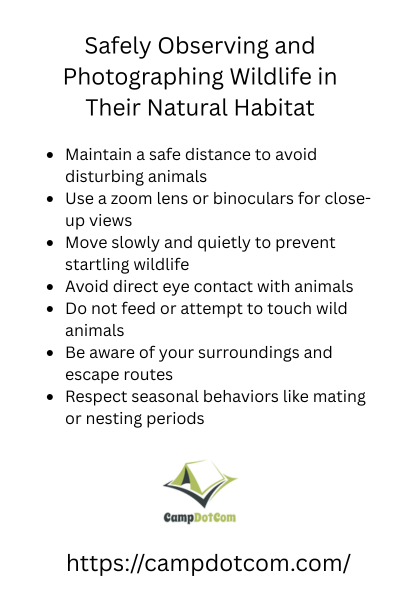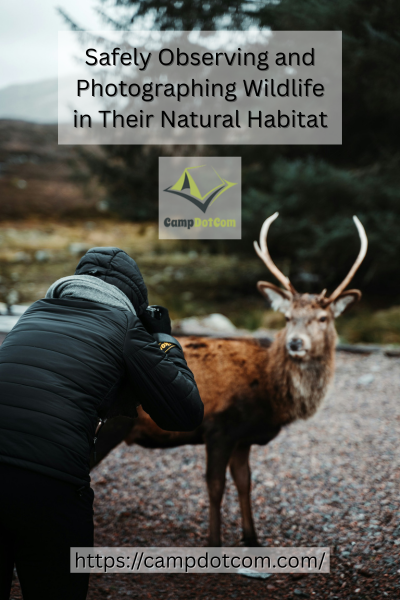Watching and photographing wildlife in their natural home is an experience that never loses its charm. There is a special kind of magic in seeing an animal go about its day, whether it is completely unaware of you or fully aware but unfazed, while you stand there with your camera, hoping for that perfect shot.
I can still picture my very first time doing this. I was in a peaceful nature reserve, crouched behind a bush with my lens focused on a heron. My heart was racing as if I had just finished a marathon, yet I held my breath to avoid startling it. When I finally pressed the shutter, it felt like I had just won a prize.
Read More About Safely Observing and Photographing Wildlife in Their Natural Habitat

Why Safety Comes First—for You and the Animals
When you’re out there safely observing and photographing wildlife in their natural habitat, safety isn’t just about not getting mauled by a bear (though, yeah, that’s important). It’s also about respecting the animal’s space so they can live without unnecessary stress.
As an Amazon Associate, I earn from qualifying purchases. Some of the links in this article are affiliate links. This means that, at zero cost to you, I will earn an affiliate commission if you click through the link and finalize a purchase.
Think of it this way: you’re stepping into their home. You wouldn’t want someone barging into your living room, flashing a camera in your face, right? Giving animals plenty of space not only protects them—it also makes for better, more authentic photos because they’ll act naturally.
I like to follow what I call the invisible guest rule: if the animal changes its behavior because of you, you’re too close.
More Things to Know About Safely Observing and Photographing Wildlife in Their Natural Habitat

Choosing the Right Gear
If you want to enjoy safely observing and photographing wildlife in their natural environment, your gear really makes a difference, but you do not have to spend a lot on professional equipment right away. A good camera with a zoom lens can work wonders, because the less you need to get physically close, the safer it is for you and the animals.
I once tried to photograph a hawk using only my phone camera. Let’s just say the “majestic hawk” ended up looking more like a blurry pigeon. That day I learned my lesson. A zoom lens lets you capture clear shots while keeping a safe distance. And if you plan to hike long distances, a light tripod can be a lifesaver—it keeps your arms from tiring and helps your shots stay steady.
Blending In and Being Patient
One of the most overlooked parts of safely watching and photographing wildlife in their natural home is blending in with your surroundings. Wearing neutral colors can help, but to be honest, patience is your greatest tool.
Wildlife photography is about ten percent action and ninety percent waiting. I have spent hours staying completely still for that one perfect shot, and you know what? It is always worth it. Bring some snacks, water, and maybe a comfy seat. When the moment arrives, you will be ready, and your photos will capture the magic.
Sometimes you might wait and nothing happens at all. That is simply part of the adventure. Nature follows its own clock, not ours.
Learning Animal Behavior
The more you understand an animal’s behavior, the easier it becomes to spot and photograph them without risk. If you are looking for foxes, learn when they are most active. If you enjoy bird watching, get to know which calls signal safety and which ones warn that trouble is close.
I once found a deer simply because I heard squirrels chattering non stop. It turned out they were alerting each other about the deer passing through. Small clues like that can lead to amazing moments and also help you steer clear of risky situations.
Respecting the Environment
Watching and taking pictures of wildlife in their natural home is not only about keeping your distance, it is also about making sure you do not leave any trace behind. If you trample plants, drop trash, or play loud music, you are affecting more than just the animal you came to see.
I always follow the rule of leaving a place exactly as I found it, or even better. This way, the next visitor, whether it is a person or a curious raccoon, can enjoy it just as much.
The Joy of the Moment
Sometimes I put my camera down completely and just watch. Sounds weird for a photographer, right? But honestly, there’s something powerful about experiencing an animal’s world without a lens in the way.
One time, while trying to photograph dolphins, I realized I was so caught up in getting “the shot” that I wasn’t even enjoying the fact that dolphins were right there. I lowered my camera and just watched them for a while. Best decision ever.
Capturing Wildlife Moments While Protecting Nature
At the end of the day, watching and photographing wildlife in their natural home is about more than just getting a beautiful picture. It is about building a real connection with nature while making sure both you and the animals stay safe.
Take it slow. Notice the patterns of the wild. Keep a comfortable distance, give them their space, and remember that the story behind the picture can be just as special as the picture itself.
So pick up your camera, bring plenty of patience, and step into their world as the kind and respectful guest you are. Who knows, your next photo might become your new favorite.
